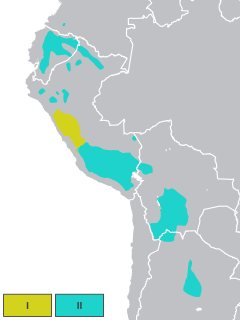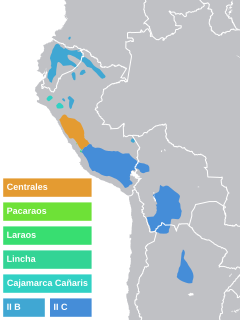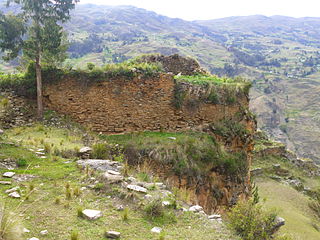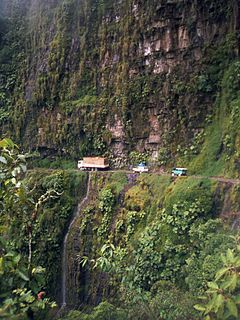
Quechua, usually called Runasimi in Quechuan languages, is an indigenous language family spoken by the Quechua peoples, primarily living in the Peruvian Andes and highlands of South America. Derived from a common ancestral language, it is the most widely spoken language family of indigenous peoples of the Americas, with a total of probably some 8–10 million speakers. Approximately 25% of Peruvians speak a Quechuan language. It is perhaps most widely known for being the main language family of the Inca Empire. The Spanish colonisers initially encouraged its use, but from the middle of their reign they suppressed it. However, Quechua ultimately survived and variants are still widely spoken today.

Southern Quechua, or simply Quechua, is the most widely spoken of the major regional groupings of mutually intelligible dialects within the Quechua language family, with about 6.9 million speakers. It is also the most widely spoken indigenous language in the entire New World. The term Southern Quechua refers to the Quechuan varieties spoken in regions of the Andes south of a line roughly east–west between the cities of Huancayo and Huancavelica in central Peru. It includes the Quechua varieties spoken in the regions of Ayacucho, Cusco and Puno in Peru, in much of Bolivia and parts of north-west Argentina. The most widely spoken varieties are Cusco, Ayacucho, Puno (Collao), and South Bolivian.

Waruq is an archaeological site in Peru. It is situated in the Huánuco Region, Yarowilca Province, Chavinillo District

Incahuasi or Incawasi is an archaeological site in Peru. It is located in the Lima Region, Cañete Province, Lunahuaná District.

Inka Wasi or Inkawasi is an archaeological site in Peru. It is located in the Ayacucho Region, Parinacochas Province, Pullo District.

Inka Wasi is an archaeological site in the Huancavelica Region in Peru. The Inca palace is considered one of the most important monuments of the Huancavelica Region. Inka Wasi is located in the Huaytará Province, Huaytará District, about 25 km from Huaytará. It is situated at a height of 3,804 m (12,480 ft).
Qurimarka is an archaeological site in Peru. It is situated in the Apurímac Region, Abancay Province, Huanipaca District.
Qurimarka is an archaeological site in Peru. It is located in the Cusco Region, Urubamba Province, Ollantaytambo District. It is situated at the river Rayanniyuq (Rayanniyoc) and it belongs to the community Rayanniyuq.
Auquilohuagra is an archaeological site in Peru. It is situated in the Huánuco Region, Yarowilca Province, Obas District. The site was declared part of the National Cultural Heritage of Peru in 2006.

Inti Watana, Intiwatana or Pumaqucha is an archaeological site in Peru. It is located in the Ayacucho Region, Vilcas Huamán Province, Vischongo District, at the lake Pumaqucha.

Choquequirao Puquio is an archaeological site in Peru. It is situated in the Cusco Region, Cusco Province, San Sebastián District, north of San Sebastián.
Kunturmarka is an archaeological site in Peru. It is situated in the Pasco Region, Pasco Province, Paucartambo District. The complex consists of round buildings and stone tombs (chullpa).

Wilca is an archaeological site in Peru. It is situated in the Amazonas Region, Utcubamba Province, in the east of the Cajaruro District, near the border with the Bongara Province.

Huaca Huallamarca also known as Huaca Pan de Azúcar, is an archaeological site in Peru. It is located in the district of San Isidro, in the city of Lima.

Kunturmarka is an archaeological site in Peru. It is situated in the Ayacucho Region, Huanta Province, Huamanguilla District.

Inti Watana or Intiwatana (Quechua) is an archaeological site in Peru. It lies in the Cusco Region, Calca Province, Pisac District.

Hatun Machay is a rock forest with archaeological remains in Peru. It was declared a National Cultural Heritage by Resolución Directoral No. 944/INC-2010 on May 7, 2010. Hatun Mach'ay is situated on the western side of the Cordillera Negra in the Ancash Region, Recuay Province, Pampas Chico District, at a height of about 4,200 metres (13,780 ft).

Auga Punta is an archaeological site in Peru located in the Huánuco Region, Huamalíes Province, Jircan District. It is situated at an elevation of ca. 3,700 m (12,100 ft) on a mountain named Jircán, near the village of Urpish.
Hatun Misapata or Misapata is an archaeological site in the Ayacucho Region in Peru. It was declared a National Cultural Heritage by Resolución Viceministerial Nº 459-2011-VMPCIC-MC of April 20, 2011. Hatun Misapata is situated in the Lucanas Province, Aucara District.
Wamanilla or Misayuq Pata is an archaeological site in the Ayacucho Region in Peru. It was declared a National Cultural Heritage by Resolución Viceministerial Nº 459-2011-VMPCIC-MC of April 20, 2011. It is situated in the Huanca Sancos Province, Sacsamarca District, and in the Víctor Fajardo Province, Huancaraylla District.













